Transforming Lives by Saving Sight
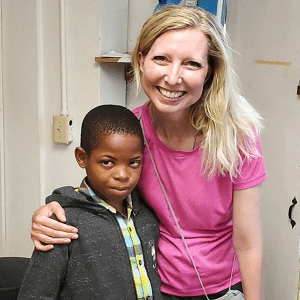 Kristin Follman had been working at a school district for 15 years when in 2017 she signed up as a logistics volunteer for the Haiti Eye Mission ― a nonprofit organization that cures and prevents blindness in Haiti. At the time, she viewed this as a one-time trip, but she was soon hooked on the mission and felt called to do more.
Kristin Follman had been working at a school district for 15 years when in 2017 she signed up as a logistics volunteer for the Haiti Eye Mission ― a nonprofit organization that cures and prevents blindness in Haiti. At the time, she viewed this as a one-time trip, but she was soon hooked on the mission and felt called to do more.
“I’m not a crier, but I was moved to tears,” said Follman. “I couldn’t believe how many people were in need and how many of them we were able to help. I was way out of my comfort zone. We are only a three-hour flight away, but how different our lives are in comparison. Until you taste the dirt in your mouth, feel the dust in your eyes and experience the poverty first-hand, it’s impossible to fully understand.”
After her fourth trip to Haiti, Follman joined the ophthalmology research team, Bergstrom Eye Research, as director of marketing and recruiting, and in June 2020 became the first official executive director of the Haiti Eye Mission.
Tell us about the Haiti Eye Mission
Lance Bergstrom, MD, FACS, joined a colleague of his on an eye care mission to Haiti in 2012. When he first agreed to assist the small mission team, he didn’t plan on leading an annual eye trip there. But within a few days, he was asked to take over. Dr. Bergstrom is a humanitarian who was drawn to ophthalmology due to its ability to quickly transform lives. After witnessing the considerable need in Haiti, he accepted the challenge and began leading the team in 2016. By 2017, the Haiti Eye Mission was incorporated as a 501(c)3 nonprofit organization.
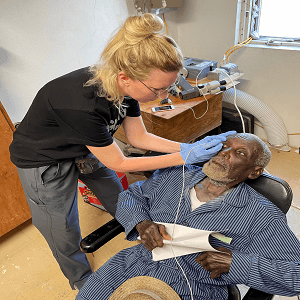 Our short-term goals are funding annual mission trips to Haiti to cover medical, travel and shipping costs as well as procuring donations of medical supplies, equipment and medications. Over time, we hope to have sustainable access to glaucoma medication through contracts for donated or low-cost drops from pharmaceutical companies and/or manufacturing the drops in Haiti and distributing them through local channels. And, to train Haitians in optometry and ophthalmology so they can have year-round eye care in that region. We would look at top students in Haiti that would be qualified, motivated and capable of higher education to enroll in school in the Dominican Republic or Port au Prince.
Our short-term goals are funding annual mission trips to Haiti to cover medical, travel and shipping costs as well as procuring donations of medical supplies, equipment and medications. Over time, we hope to have sustainable access to glaucoma medication through contracts for donated or low-cost drops from pharmaceutical companies and/or manufacturing the drops in Haiti and distributing them through local channels. And, to train Haitians in optometry and ophthalmology so they can have year-round eye care in that region. We would look at top students in Haiti that would be qualified, motivated and capable of higher education to enroll in school in the Dominican Republic or Port au Prince.
There are many countries dealing with vision impairment and the inability to provide their citizens with affordable or any eye care. Why was Haiti chosen?
Harsh sunlight, poor nutrition and strong genetic mutations have made cataracts and glaucoma an epidemic in Haiti, affecting nearly 20% of the population and causing debilitating blindness that shatters lives. These diseases are completely preventable if treated in time. But in Pignon, the poorest region of Haiti, there is no eye care within a four-hour radius. This is what drives our team at Haiti Eye Mission to bring a mobile eye care clinic to the region each year and is fueling our push to empower residents to provide sustainable eye care year-round.
What has been the organization’s impact thus far?
Since taking over the helm, we have both scaled and expanded the scope of Haiti Eye Mission to address the overwhelming eye care needs facing Pignon residents — even during a pandemic and political unrest in the country. Over the past six years, we have:
- Expanded our medical staff and logistics team from eight to 25 members.
- Established an eye screening and education program for more than 1,400 patients per year.
- Increased the number of manual small incision cataract surgeries (MSICS) tenfold, from about 25 to 300+ each year.
- Incorporated 150+ laser surgeries per year to halt glaucoma.
- Provided glaucoma drops for year-round treatment ($3 million combined for 2021 and 2022).
- Made extensive improvements to the existing infrastructure at the hospital in Pignon. This included adding a second operating room in a mobile army surgical hospital (MASH) tent and purchasing generators and air conditioning units to boost critical access to power and to keep heat sensitive surgical equipment working properly.
- Improved and increased the ophthalmic equipment used for screening, patient exams and surgeries.
- Solidified partnerships with two schools, TeacHaiti and FOCUS, to help identify future medical students to assist us in Pignon.
Looking ahead, we are focusing on a long-term sustainability plan to ensure the people of Pignon always have access to vision-saving eye care. Our sustainability plan, which we intend to fully implement by 2032, includes the establishment of a full-service eye clinic in Pignon and the transition of Haiti Eye Mission to a supervisory role.
There must be a lot of moving pieces involved from the beginning until when you return to the U.S. Walk us through all the planning and preparation that goes into a trip.
Planning for the next trip starts as soon as we land back in the U.S. Our team meets as a group the day after we return to discuss what went well, 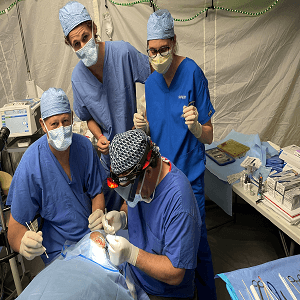 what could be improved and create a list of needed supplies and equipment for the next trip. We order, pack, weigh and ship over 3,000 pounds of supplies that we bring with us each year. I oversee all the supply ordering, requesting in-kind donations, keeping inventory and managing all the trip logistics for the entire team.
what could be improved and create a list of needed supplies and equipment for the next trip. We order, pack, weigh and ship over 3,000 pounds of supplies that we bring with us each year. I oversee all the supply ordering, requesting in-kind donations, keeping inventory and managing all the trip logistics for the entire team.
In addition to trip coordination, I also keep donors informed on our annual trip successes and foster lasting relationships with those that believe in our mission. Funding sources and fundraising options are constantly being pursued as our mission continues to grow. Our dedicated board of directors have all travelled with the team to Haiti and truly believe in the work of our mission. The board meets monthly for strategic planning that moves us toward the incorporation of our goals.
You manage so much. What does the team look like? What are their roles and responsibilities, including the volunteers?
Our team consists of both medical professionals and volunteers. We have between 20-25 in the group each year and every dedicated team member handles their own trip costs. We have surgeons, optometrists, surgical techs and Certified Ophthalmic Assistants (COA) travel with the team and work tirelessly to treat the hundreds of patients that travel to see us each day. We also have many highly skilled volunteers that return for multiple trips. Those volunteers take on many different roles from building maintenance, ensuring we have power from generators, sterilizing instruments and countless other duties as they arise. We work 12-15 hour days in very primitive conditions, seeing approximately 350 patients each day. Many of our patients walk for hours or days to see us and they have no other source of eyecare. We don't leave until the last patient is given an exam! "Golden tickets" are given to those that arrive too late to get on the surgery schedule. It's our promise to return next year and give them sight-restoring surgery.
Are there ways for individuals to get involved? If yes, what are they?
We are always looking for people to join our team. If you are interested and want to learn more, please email kristin@bergstromeye.com and check out our website.
Patient Success Stories
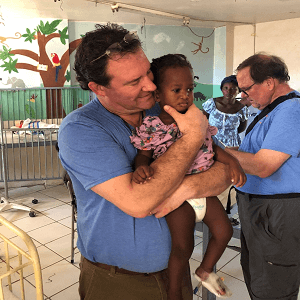 Our Youngest Patient
Our Youngest Patient
Tiya was shopping at a vegetable market in her rural village when she heard a rumor that our eye care team was in Pignon. She didn’t know if the rumor was true, but desperate for the chance to give her 18-month-old son, Pierre, back his sight, she used her last $3 to pay for the hour and a half motorcycle ride to Pignon. Our eye care team had never operated on a patient so young and when the patches were removed and he was able to see, we all fought back tears of joy.
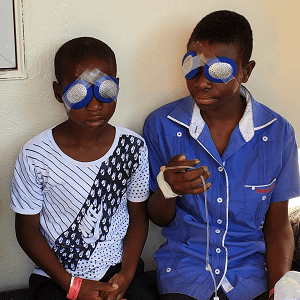 From Completely Blind to Having Sight
From Completely Blind to Having Sight
Eleven-year-old Pierre and 14-year-old Frantz were both completely blind when they showed up at our eye care clinic. The cousins had both lost their vision to severe cataracts and we immediately went to work to give them back their sight. When the patches were removed the morning after their cataract surgeries, the boys were elated. The first thing they asked was, “Can we go to school now?”
